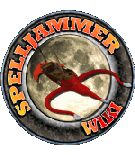The Cuttle Command is a spelljamming ship built and used by humans.
Description
Designed by the same humans who allied with the illithids to create the Octopus, the Cuttle Command was built using several of the features of the Octopus, but without the direct input of illithid designers. As the name suggests, the Cuttle Command was intended as a command vessel to coordinate human vessels during the first Unhuman War. The Cuttle Command is a ten-story-tall tower in space. It is even taller than it is wide along its hull. The gravity plane is maintained by the eight large tentacles, four of which mount heavy weapons. These tentacles extend far enough horizontally to change the orientation of the gravity plane, however this results in a ship which is less maneuverable than it could be otherwise. These tentacles can be pulled in close to the ship in an emergency, granting the Cuttle Command a maneuverability class of C, however this is rarely done, since the sudden shift in the gravity plane is disastrous for anything and anyone not strapped down.
The Cuttle Command was to be the answer to the elven Armada, proof that an organized human community could create great command ships to destroy the humanoid menace. Unfortunately, the human organization proved to be far less cohesive than that of the elves. In the one large battle of the Unhuman War in which Cuttles participated, they appeared on both sides. Turncoat mercenaries seized one ship and turned it against its builders.
Crew
The Cuttle Command was set up as a command vessel and information centre, with the "brains" hidden within the protective shell. The Cuttle Command could support a full fleet command staff, and included about half its number in heavily-armed raiders and defenders. Historically, Cuttle Commands were well-armed with magic as well, typically carrying about a dozen battle mages. The captain of such a ship was usually also a powerful mage rather than a warrior.
Ship Uses
Command Ship: Only about a score of Cuttle Commands were originally built, and all of these were intended to serve as command ships for human fleets opposing the goblinkin. These mobile command bases were never really intended to serve directly in combat, but were sufficiently armed to defend themselves if the other ships in the fleet were unable to prevent an enemy from reaching them. While some impetuous captains and admirals piloted their Cuttles directly into enemy formations, the ship was actually designed to coordinate the attacks of other ships from a distance. To this end, a Cuttle Command was typically equipped with magical devices to allow long-range communication with the ships under its command. Some Cuttle Commands are still used in this function today.
Wizard's Ship: The tower-like configuration of the Cuttle Command tends to appeal to human wizards, and the design quickly spread to powerful mages on many worlds through a network of magical contacts. This has resulted in new Cuttle Commands periodically appearing in space as wizards decide to build the craft as experiments. Such ships are usually piloted and captained by the wizard who built them. Since such powerful wizards are often fairly solitary in nature, the rest of the crew is often made up primarily (or even entirely) of magical servants and constructs. These Cuttles are typically used by their masters for research, solitude, and exploration. Because the nature of the crew is so variable, experienced spacers tend to avoid lone Cuttle Commands, since it is impossible to guess what they may be facing if hostilities erupt, and since it is equally impossible to guess what actions may cause hostilities to erupt!
Other Configurations
Alternate Weapons: The Cuttle Command's precarious gravity plane simultaneously cries out for modification at the same time that it makes such modification extremely difficult. Extensive modifications to the hull or rigging tend to unbalance the ship, with tragic results, unless performed by a master shipwright with an exceptionally skilled team of workers. As a result, the only common modification seen in Cuttle Commands is a change in weaponry. The most common variants are those which carry all ballistas, or all catapults. There was a Cuttle Command armed with multiple greek fire projectors, the Ultimate Victory; however it was destroyed in a mutiny when the mutineers captured a weapons platform and turned it against the ship. Some Cuttle Commands mount additional heavy weapons on the observation platforms on decks one and ten, while one notable Cuttle, the Battle Cry, was also equipped with extra weapons platforms on the four lower tentacles, carrying a total of 6 heavy ballistas, 6 heavy catapults, and 2 heavy jettisons. The Battle Cry survived the first Unhuman War, and has been successfully used as a mobile defense platform ever since.
References
- Spelljammer reference: 1065XXX1903
- TSR reference: TSR 1065
- ISBN: 1-56076-134-2
